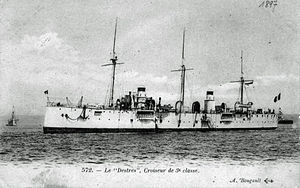French cruiser Destrées
 |
|
| History | |
|---|---|
|
|
|
| Name: | Destrées |
| Namesake: | Victor-Marie d'Estrées |
| Laid down: | 3 May 1897 |
| Launched: | 27 October 1897 |
| Completed: | 1899 |
| In service: | 1899 |
| Out of service: | 27 October 1922 |
| Fate: | Sold for scrap |
| General characteristics | |
| Class and type: | Destrées-class cruiser |
| Displacement: | 2,500 tonnes (2,461 long tons) |
| Length: | 95 m (311 ft 8 in) |
| Beam: | 12 m (39 ft 4 in) |
| Draught: | 5.4 m (17 ft 9 in) |
| Installed power: | 8,500 shp (6,338 kW) |
| Propulsion: | 8 boilers |
| Speed: | 20.5 knots (38.0 km/h; 23.6 mph) |
| Complement: | 235 |
| Armament: |
|
Destrées was a protected cruiser of the French Navy, named in honour of Victor-Marie d'Estrées, and lead ship of her class.
Destrées underwent sea trials and received her armament at Rochefort. After her trials she was sent to Brest in February 1900, where she was used for training. In 1902 she served in the Atlantic, and was placed on the Newfoundland station.
At the outbreak of the First World War, she was appointed to the 2nd light cruiser squadron in the English Channel, before being sent to the Eastern Mediterranean in 1915.
On 30 April, she reached Port Said and was tasked with the defence of the Suez Canal. In September, she took part in rescue operations to save people from the Armenian Genocide.
After the War, she was sent to the Far East.
Removed from active service in 1922, she was used as a support ship in Toulon before being sold for scrap.
...
Wikipedia
